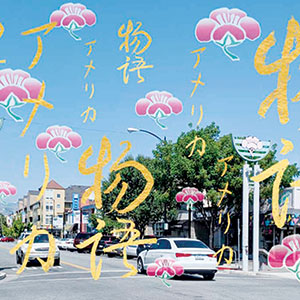Features & Columns
Silicon Alleys: Daikon Pixels
 BRUSH THE SKY: Artist Tamiko Thiel uses futuristic AR technology to explore history. Photo Illustration by Tamiko Thiel
BRUSH THE SKY: Artist Tamiko Thiel uses futuristic AR technology to explore history. Photo Illustration by Tamiko ThielWith gentrification continuing to reshape Japantown, one of San Jose's most historic neighborhoods, a group of artists and historians pooled their resources to explore hidden histories via the use of augmented reality (AR) technology. When the opening reception unfolds this Saturday from 4-6pm at Art Object Gallery, the past will no longer be prologue.
AR is already used in the real estate industry to aid aspiring homeowners in their pursuit of the American Dream, either by envisioning what the house will look like before it's finished, or by testing out different options for the interior design.
So why not use AR to highlight all the culture destroyed by politicians and real estate developers in Japantown? It's a fantastic idea.
The Knight Foundation funded the project by awarding its Immersive Technology in the Arts grant to the Japanese American History Museum of San Jose (JAMsj). Local historians Tom Izu and Susan Hayase spearheaded the idea. So far, the Hidden Histories of Japantown project is off to an amazing start, although several bugs were still being worked out at presstime. The whole team is definitely putting the grant money to good use. Plus, one doesn't need super tech chops to make this particular AR experience happen.
"We want to convey the idea that animates our project—that tech is not just for corporations to commoditize and productize and profit from," said Hayase. "It's not something that should be intimidating to regular people. We can use it and liberate it so that community artists and historians and local history nuts and community people can see their stories told in a way that really values place, people that lived there, stories, and the art they inspire."
For the uninitiated, here's how it works. On a smartphone, the user simply downloads a free application—in this case, Tamiko Thiel's AR-vos app—which then overlays computer-generated imagery on the camera's view of the real world, enabling the user to experience an alternate, "augmented" reality. One visits a location in the physical world, i.e., an alley between Fourth and Fifth Streets, then opens up the app, points the phone toward the designated space and the experience comes into view. The only caveat is that one really needs a newer, faster phone for it to work.
As a result, nine artists have now created over a dozen AR-based works that resurrect the forgotten stories of the neighborhood. Some are college students, while others are more seasoned practitioners in different media. The more established artists thus get to expand their practice and the younger artists learn that Japantown is more than just sushi restaurants.
For example, Kiki Wu, a recent SJSU graduate originally from Taiwan, discovered the entire history of San Jose's Ng Shing Gung (Temple of the Five Gods), which she didn't know beforehand. Her piece, Safe and Sound, recreates San Jose's own Da Jiu or Hungry Ghost Festival, which unfolded over a century ago in the old Chinatown, aka Heinlenville near Sixth & Taylor. The festival took place to honor the dead, centered at the Ng Shing Gung. Papier-mache figures stood in front of the temple to serve as guardian effigies, before getting burned on the last evening of the festival to satisfy the spirits. Currently, this piece can be viewed in front of the San Jose Buddhist Temple on Fifth Street, but it will be moved to Heinlenville Park after the mega-construction adventure is completed.
In another case, Kelly Nishimura, a fourth generation Japanese-American from Sunnyvale, included abstract images of the Japanese internment camp poster gradually disintegrating into pieces. The effect is haunting.
These days, since San Jose is characterized by, or even defined by, its own destroyed history, one can easily expand on this project. Why limit the funding to Japantown? Why not take it to the SoFA District? Say, if a real estate developer demolishes a decades-old Vietnamese supermarket just to build 20 floors of apartments for dining-scene hipsters, then AR could be used to showcase the history of all the people and activity erased by the developer.
That's just one example. I'm sure anyone with an interest in culture can think of many more. It's time to summon the ghosts and build the future!


